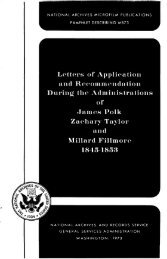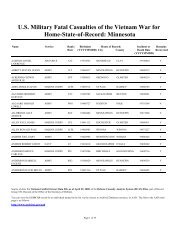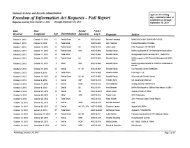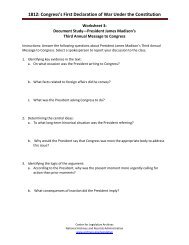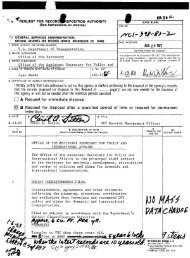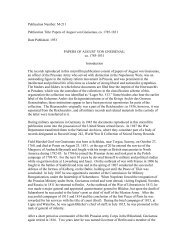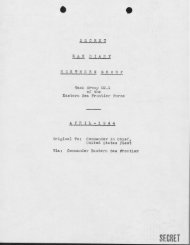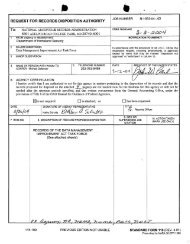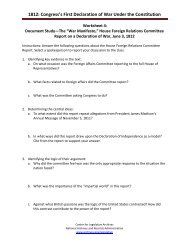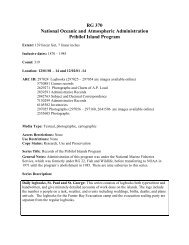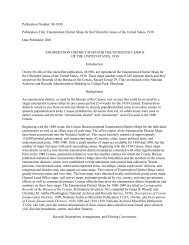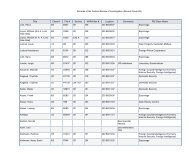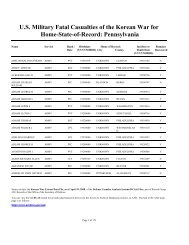HITLER'S SHADOW - National Archives and Records Administration
HITLER'S SHADOW - National Archives and Records Administration
HITLER'S SHADOW - National Archives and Records Administration
You also want an ePaper? Increase the reach of your titles
YUMPU automatically turns print PDFs into web optimized ePapers that Google loves.
literally hacking Poles to pieces. Every day … you can see the bodies of Poles,<br />
with wires around their necks, floating down the river Bug.” 17 On a single day,<br />
July 11, 1943, the UPA attacked some 80 localities killing perhaps 10,000 Poles. 18<br />
As the Red Army moved into western Ukraine (it liberated Lwów in July<br />
1944) the UPA resisted the Soviet advance with full-scale guerrilla war. Maltz<br />
noted that, “Most of the B<strong>and</strong>era gangs, men <strong>and</strong> women, from the villages …<br />
are still hiding out in the woods, armed to the teeth, <strong>and</strong> hold up Soviet soldiers.<br />
The Soviets may be the rulers of the towns, but the B<strong>and</strong>era gangs reign supreme<br />
in the surrounding countryside, especially at night. The Russians…have their<br />
h<strong>and</strong>s full…. Hardly a day passes without a Soviet official being killed….” 19<br />
The B<strong>and</strong>erists <strong>and</strong> UPA also resumed cooperation with the Germans.<br />
Though the SD was pleased with the intelligence received from the UPA on<br />
the Soviets, the Wehrmacht viewed B<strong>and</strong>erist terror against Polish civilians as<br />
counterproductive. 20<br />
In July 1944 nationalists in Ukraine formed the Supreme Ukrainian<br />
Liberation Council (UHVR), which served as an underground Ukrainian<br />
government in the Carpathian mountains. The UPA, now operating against<br />
the Soviets in smaller groups, was its army. The dominant political party in<br />
the UHVR was the B<strong>and</strong>era group. 21 In September 1944 the Germans released<br />
B<strong>and</strong>era <strong>and</strong> Stetsko from Sachsenhausen. Berlin hoped to form a Ukrainian<br />
<strong>National</strong> Committee with both OUN factions <strong>and</strong> other Ukrainian leaders.<br />
The Committee was formed in November, but B<strong>and</strong>era <strong>and</strong> Stetsko refused to<br />
cooperate. They escaped from Berlin in December <strong>and</strong> fled south, emerging after<br />
the war in Munich. 22<br />
By 1947 some 250,000 Ukrainians were living as displaced persons in<br />
Germany, Austria, <strong>and</strong> Italy, many of them OUN activists or sympathizers. 23<br />
After 1947 UPA fighters began crossing into the U.S. zone, having reached the<br />
border on foot through Czechoslovakia. They tended to be B<strong>and</strong>erist in their<br />
sympathies. We cannot describe here the background of most UPA men who<br />
reached the U.S. zone. 24 But Mykola Ninowskyj’s story, which comes from<br />
a 1956 West German arrest report obtained by the CIA, may be typical. Born<br />
in 1920, Ninowskyj joined one of the Ukrainian battalions that advanced into<br />
East Galicia under German comm<strong>and</strong> in 1941. Later in the year he joined the<br />
201st Schutzmannschaft (Auxiliary Police) Battalion, which conducted what he<br />
76 | Collaborators



